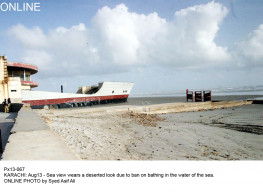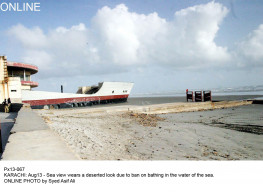
KARACHI:
He left home to celebrate Eidul Fitr with five of his friends. Three of them never came back.
Sixteen-year-old Omar Zaib was one of the 40 who drowned at Seaview on July 30. For his family, the pain is still fresh, even though the tragedy is no longer in the news.
“He was very talented and used to work as a skilled helper for jewellers to help support our family,” says Omar’s grieving brother Fazal Kareem, asking despairingly, “How do you console a mother who has lost a young son?”
The police are initially unwilling to share the list of the names and ages of those who drowned. But a look at this list makes the tragedy hit the reader harder. Ayaz, 13, son of Sawali Khan. Amir, son of Umar Illahi, aged 15. Fourteen-year-old Ejaz Ahmed, son of Ali Zaman. A mere glance shows you who would flock to the turbulent seas even in the high tide of the monsoon season. They were all between 13 to 27 years old. They were all young men. They were residents of Sohrab Goth, Baldia Town, Orangi Town and Bhains Colony.

With few options for entertainment for the recreation-starved public, the trend of taking to the sea will continue. “We see high risk-taking behaviour in this age group, because they have excess energy and not many responsibilities,” says clinical psychologist Sarah Jafry, who works with adolescents at War Against Rape. “If we cannot provide them with healthy outlets, seeking thrills even at the risk of life will continue, and even after seeing bad examples, young men will not be able to resist the urge.”
While Karachi commissioner Shoaib Siddiqui says that most of the beach has now been reopened, the public trying to visit it says otherwise. Anwar Bhutto, the duty officer at Darakhshan Police Station, confirms that Section 144 had been imposed for 90 days and the beach remains off-limits. Siddiqui, however, maintains that only the area behind Dolmen Mall is closed. “This is because it is reclaimed land and we have suspicions about dredging and depression in that area,” he says, adding that there should be evaluations about how construction near the beach might enhance risks.
Most of the bodies of the drowned were found on the same day, but it took three days to recover Omar’s body. “We kept trying to console and pacify the relatives until the bodies were found,” says Anwar Kazmi of the Edhi Foundation. “Some of them were recovered from distant areas such as Manora and Keamari.”
Omar’s family, and the families of the others who drowned, still await monetary compensation. Sindh Chief Minister Qaim Ali Shah promised them Rs0.2 million, while Malik Riaz pledged Rs1 million.
“I cannot comment on why Riaz has not given the money he promised,” says Siddiqui. “As for the sum promised by the CM, the cases have been sent to the Relief Commissioner and hopefully the families will get the money soon.” He added that they should call 1299 to follow up on it.
“We have always honoured our social welfare commitments,” says Bahria Town’s marketing manager Nida Zahoor, when asked about Riaz’s pledge. “We are only waiting for the list of the deceased from the Sindh Governor.”
Meanwhile, Kareem, whose family is from Buner in Khyber-Pakhtunkhwa and now resides in the Boulton Market area, has only this to say: “We are poor people. We could use that money to marry off our sisters. But we have no hope.”
Published in The Express Tribune, September 5th, 2014.


































































COMMENTS
Comments are moderated and generally will be posted if they are on-topic and not abusive.
For more information, please see our Comments FAQ